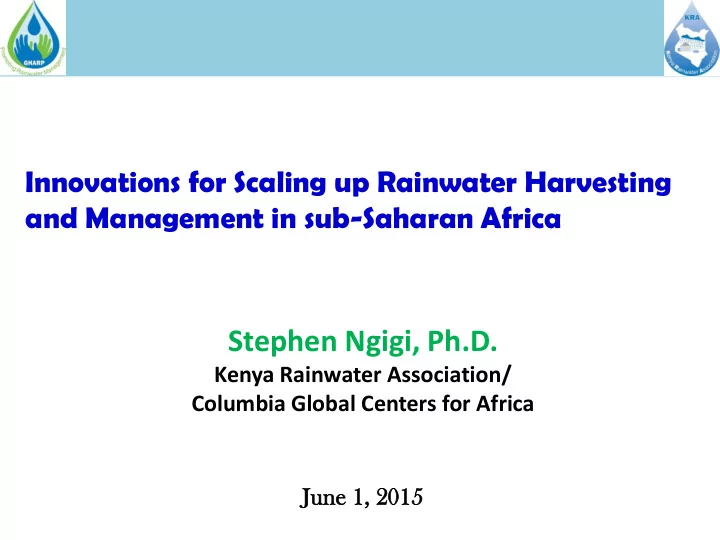

Innovations for Scaling up Rainwater Harvesting and Management in sub-Saharan Africa Stephen Ngigi, Ph.D. Kenya Rainwater Association/ Columbia Global Centers for Africa Jun une 1, 1, 20 2015 15
1 of 14 What is an Innovation? • Innovation is a new idea, more effective device or process. • Innovation can be viewed as the application of better solutions that meet new requirements , in articulated needs, or existing market needs. • This is accomplished through more effective products, processes, services, technologies, or ideas that are readily available to markets, governments and society. • The term innovation can be defined as something original and more effective and, as a consequence, new, that "breaks into" the market or society. • Innovation refers to the notion of doing something different rather than doing the same thing better. • An innovation must be replicable at an economic cost and must satisfy a specific need.
2 of 14 Introduction Innovations • Technology (storage and utilization) • Financing mechanisms • Implementation approaches • Sustainability aspects Desired Results & Impacts: CC Mitigation, CC Adaptation, Food & Nutrition Security and Improved Livelihoods Leading to: Adoption, adaptation & increased investments for scaling up – hence need for a integrated business plan
3 of 14 Farmers ’ Innovations and Challenges Simple on-farm water storage ponds: irregular shapes, steep side slopes, siltation, physical and health risks High water losses: High Seepage and Evaporation (40-60%)
4 of 14 Learning from Past Experiences to avoid reinventing the wheel Seepage losses: Lining with either concrete, masonry, UV-resistance plastic Evaporation losses: Roofing with iron sheets, thatch, vegetation e.g. non- flowering passion fruit High investment costs: Need for cost-effective interventions
5 of 14 Research-based Solutions P Graduated staff E w gauge Kitchen garden Q r Q i h 1 r Q p n d V ( Q PA ) Q E A Q r i w p d t Note: Seepage and evaporation losses accounted for 40-60%
6 of 14 Innovation: Evolution of the Farm Pond Technology Increasing water storage and reliability: Reducing water losses and health risks Enhancing cost-effectiveness /durability and environmental sustainability
7 of 14 Innovation: Smallholder F armers’ Drip Irrigation Technology
8 of 14 Innovation: Farmers’ Adopted Low -cost Greenhouses Note: 1. The wooden greenhouses are not durable and last for only 2-3 years 2. Investment cost ranges from $ 800-1,000 and seasonal income of $ 1,000 -2,000 3. Thus given the options, farmers can invest in low-cost metallic greenhouses
9 of 14 I nnovations: Modifying and Upgrading Farmers’ Technology Note: 1. The metallic greenhouses are durable and their performance is excellent 2. Investment cost ranges from $ 1,000 – 3,000 depending on the size 3. Smallholder farmers can invest in the technology if effective incentives are used
10 of 14 Implementation: Phased and/or Selective Adoption A farmer can start with the lining, then roofing later or opt for fencing especially for large farm ponds (>150m 3 ) depending on cost & cash- flow/source of funding
11 of 14 Implementation approach: Integrating Farm Pond with Greenhouses Promoting sustainable and cost-effective innovations for smallholder farmers – income generation is driving the process
12 of 14 Sustainability Aspects: Business Enterprise development Transforming Smallholder Farmers from Subsistence to Commercial Agriculture with linkage to the markets through farmers’ cooperatives/ marketing associations
13 of 14 Sustainability Aspects: Ownership? When technology fails Harvesting silt instead of water!
14 of 14 Conclusion: Scaling Up Innovations and Technology Transfer • Situational analysis – learn from farmers’ experience and knowledge, and roles of different stakeholders • Problem diagnosis – quantify the problem to confirm and demonstrate farmers’ challenges and new innovation • Provide viable and innovative options to address the problem and adopt the most cost-effectiveness innovation that is acceptable to the farmers to enhance adoption • Do not reinvent the wheel – build from farmers’ and past experiences and blend with modern technology • Technology promotion should demonstrate how the technology works and its impacts – real life experience with supporting data to verify the performance & outcome
THANK YOU
Recommend
More recommend